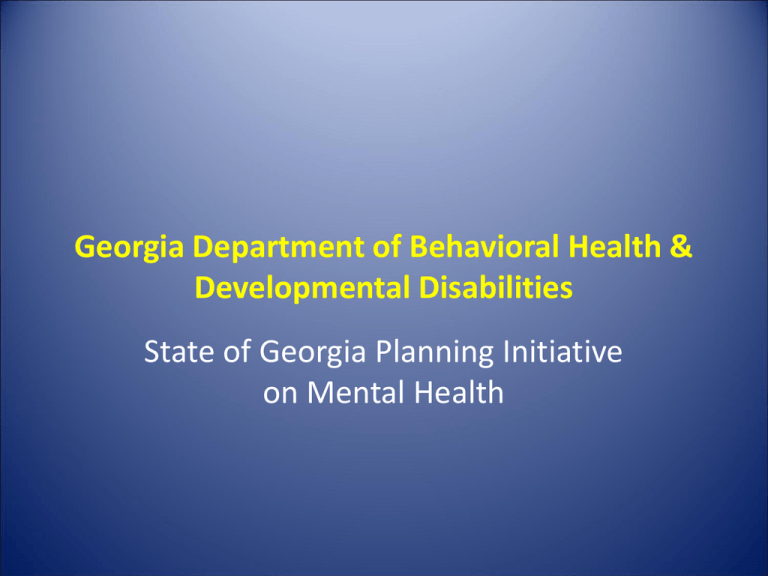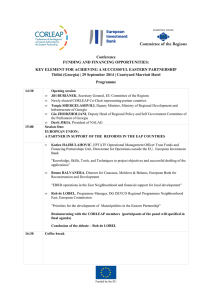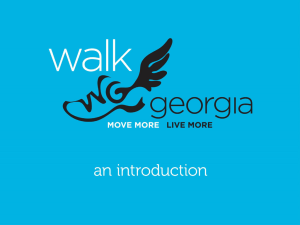Georgia Department of Behavioral Health
advertisement

Georgia Department of Behavioral Health & Developmental Disabilities State of Georgia Planning Initiative on Mental Health Planning Initiative • The December 2008 report of a gubernatorial Mental Health Service Delivery Commission; • Priorities raised by advocates and providers in a series of meetings with Drs. Shelp and McDonald; • A Voluntary Compliance Agreement with the federal Office of Civil Rights in the Department of Health and Human Services regarding Olmstead issues and the need to demonstrate compliance; and, a CRIPA Settlement Agreement with the federal Department of Justice; • A new state organizational structure and new senior management hired in response to the recommendations of the Commission report to create a separate Department of Behavioral Health and Developmental Disabilities (DBHDD). Community Partners • Federal Center for Mental Health Services (Bill Hudock), the federal Center for Medicare and Medicaid Services , the Carter Center (Tom Bornemann PhD), the Bazelon Center for Mental Health Law (Bob Bernstein, PhD), Atlanta Legal Aid Society (Talley Wells and Sue Jamieson), Georgia Legal Advocacy Office (Josh Norris and Ruby Moore), Georgia Association of Community Service Boards (Darril Gay PhD Tom Ford, Tod Citron), national experts in inpatient hospital care (American Health and Wellness Institute), the Behavioral Health Services Coalition of Georgia (Ellyn Jeager)which represents over twenty-five organizations including Mental Health America of Georgia and the National Alliance for Mental Illness, the Mental Health Planning and Advisory Council (Pierluigi Mancini, PhD), the Georgia Consumer Support Network (Sherry Jenkins Tucker) as well as national expert in peer support (Larry Fricks), Georgia Council on Substance Abuse (Neil Kaltenecker), Georgia Parent Support Network (Sue Smith, Ed D), Georgia Psychiatrists Physicians Association (Lasa Joiner), private housing providers/ specialists (Jean Toole, Ken Whiddon and Paul Bolster), Sheriff’s Association (Sheriff Terry Norris), Georgia Board of Regents (Ben Robinson), Emory University (Bill McDonald, MD and Eve Byrd, MSN, MPH), Medical College of Georgia (Peter Buckley, MD), Mercer University School of Medicine (Melton Strozier, PhD), Georgia Hospital Association (Matt Crouch), and stakeholders and advocates from across the state to evaluate and develop a comprehensive plan for community support for patients with SPMI. Georgia Behavioral Health Stakeholders Priorities and Process Discussion June 15, 2009 Carter Center Mental Health Service Delivery Commission Final Report Recommendations Community-Based Crisis Stabilization Supported Housing Continuum of Case Management Services Common Preferred Drug List Supported Employment Transportation Uniform Children’s Benefit Package Adult Services Behavioral Health Collaborative Inpatient Services Coordinating Council • Chaired by Dr. Shelp – Includes the commissioners of DCH, Human Services, Corrections, Juvenile Justice, a member of the House, a member of the Senate, an adult receiving DBHDD services, a family member of a consumer and an adult parent of a child receiving services – Projects to include • developing a common formulary and HIE • areas in which the DBHDD can maximize funding from federal and private sources Populations of Focus • Long term residents of State Psychiatric Hospitals who can be served in the community and are subject to attention under the Olmstead decision and the Voluntary Compliance Agreement with the federal Office of Civil Rights. • People who are recently or frequently readmitted to the State Psychiatric Hospital. • People who currently are, or recently were, incarcerated and who have mental health and potentially co-occurring substance use condition treatment needs. • People who are chronically homeless and who have mental health and potentially co-occurring substance use condition treatment needs. This population typically is difficult to serve, more apt to have expensive and complex physical illnesses, and apt to deteriorate significantly in the absence of appropriate treatment and supports. • Children and adolescents with severe emotional disturbances In the next one to three years: • Increase community behavioral health services capacity • Improve access to local community based behavioral health services • Improve inpatient care Increase community capacity: Expand the Medicaid Plan • Partnership with DCH: Dr. Meadows and Catherine Ivy • SSI/ SSDI Outreach, Access Recovery program or SOAR process • DBHDD and DCH are obtaining technical assistance from CMS on cost reporting to improve the Medicaid reimbursement for providers • Targeted Case Management (TCM) and a state 1915i Medicaid plan amendment 1915i • Bill Hudock (federal Center for Mental Health Services), John O’Brien (federal Center for Medicaid and Medicare), Wendy Tiegreen (DBHDD) and Catherine Ivy (DCH) • Medicaid plan amendment and not a waiver – Only two states have a 1915 amendment (Iowa and Wisconsin) – Budget neutrality not required – Can be limited with waiting list and specified to region 1915i number served • • • • • Year 1: 7/1/2010- 6/30/2011- 175 Year 2: 350 Year 3: 550 Year 4: 775 Year 5: 975 1915i: Population served • Stay in a state psychiatric hospital of over 60 days in the last 12 months; • Three (3) or more hospitalizations/crisis stabilization admissions in the last 24 months; • Hospitalized in a state psychiatric hospital in the past year AND chronically homelessness defined by either one of the following: – a) continuously homeless for one full year; OR – b) having at least four (4) episodes of homelessness within the past three (3) years; • Hospitalized in a state psychiatric hospital in the past year AND multiple incarcerations in the last 12 months; • Currently resides in a behavioral health treatment or support residence AND meets a LOCUS level 4, 5, or 6 at the time of evaluation indicating the risk of rehospitalization or homelessness. 1915i: Person-Centered Planning & Service Delivery • The care coordinator will provide information both verbally and in writing to the participant about the person-centered planning process, their opportunity to include others to participate in the planning the services available through the program and that they will be able to select qualified service providers of their choice. 1915i: Supports provided • Supporting housing retention (such as crisis coping skills, dispute resolution and peer mentoring,); • Building and maintaining independent living skills (such as meal planning and preparation, household cleaning, shopping, budgeting, community resource access and utilization and wellness, recreational and social activities); • Facilitating mental health, medical, dental and (when indicated) substance abuse appointments and treatment; • Family services including family reunification facilitation and parenting classes; • Medical and non medical transportation; • Monitoring or directly providing personal care services. All recovery-building activities are intended to support successful community living through utilization of skills training, cuing and/or supervision as identified in the individualized supports plan. 1915i: Supportive employment • Supported employment is a comprehensive approach to vocational rehabilitation whereby the employment specialist works with the individual, the family, and the treatment team (practitioners who provide services such as case manager, therapist, psychiatrist) to integrate supported employment with mental health treatment toward promoting recovery. The goal of supported employment is to help people with the most severe disabilities participate in the competitive labor market, work in jobs they prefer with the level of professional help they need, and help people advance in their careers. Major activities may include: employment assessment – assessment is based on a person’s interests, skills, and prior experience and primarily occurs in the community; job training – assistance for the individual to begin work, learn the job and interact appropriately with co-workers, customers, and supervisors (coaching, teaching, assistive technology, and accommodations); ongoing support to maintain employment – offered are career development, access to educational opportunities, coaching, vocational educational classes, job counseling, transportation, changes in the treatment plan, and assertive outreach to the client. 1915i: Addiction Services • • • In addition, the planning team must have access to: An addiction specialist (Certified Addiction Counselor II (or equivalent) or addictionologist for planning consult (not face-to-face) if the evaluation indicates an addiction issue co-occurring with a psychiatric issue; AND A psychiatrist for providing consult as needed to assist with the functional goals/objectives set forth during planning Increase community capacity: Expand the Provider Network • Well developed provider network – Medicaid waiver programs including the Service Options Using Resources in a Community Environment (SOURCE), Community Care Services Program (CCSP), and Independent Care Waiver Program (ICWP) for patients with traumatic brain injury. Increase community capacity: Expand the Provider Network SOURCE FY09 18415 FY08 16315 FY07 13236 FY06 9442 FY05 7623 FY04 4952 FY03 Series1 2785 FY03 2785 FY04 4952 FY05 7623 FY06 9442 FY07 13236 FY08 16315 FY09 18415 Increase community capacity: Expand the Provider Network • Audrey Sumner completed fidelity scores to the Dartmouth Assertive Community Treatment (ACT) model of the sixteen ACT programs – ACT teams in the state will meet next week with the Olmstead planning committee to determine which Olmstead patients can be transitioned into the community with housing – Pathways to Housing Program Increase community capacity: Expand the Provider Network • Pathways to Housing Program – Housing first – Train the trainer – 75 clients – Presently in procurement Increase community capacity: Improve the supportive housing network • Housing subcommittee (Stan Jones and Jean Toole with Talley Wells) – Engage DCA: Doug Scott and Ron Pounds – Georgia’s model housing collaboratives between CSB’s and local housing authorities will a conduct a workshop providing technical assistance to other CSB’s and housing authorities regarding applying for grants to develop supportive housing programs. – The Georgia Community Service Board Association has agreed to develop a strategy, to be completed by April 2010, for increasing the capacity of supportive housing currently being provided by CSBs – List of administrative policies and procedures mandated by the state which increases the providers’ administrative costs for providing housing and decrease their service dollars therefore decreasing their capacity. Increase community capacity: Develop systems of care for children and adolescents • Child and adolescent subcommittees (Chairs Sue Smith and Cynthia Wainscott) – Modeled after WrapAroundMilwaukee • provide comprehensive, individualized and cost effective care to children who have serious emotional or mental health needs, and are referred through the Child Welfare or Juvenile Justice System and are at immediate risk of placement in a residential treatment center, juvenile correctional facility or psychiatric hospital. Increase community capacity: Develop systems of care • Grant for 3.8 million to develop systems of care using the federal funding for the Community-Based Alternatives for Youth (CBAY) demonstration project designed after evidence based WrapAroundMilwaukee • Four care management entities (CME’s) of 283 children with severe emotional disturbances using the Wraparound Milwaukee system of care • Synthesis software Increase community capacity: Develop systems of care for children and adolescents • $480,000 grant from SAMHSA for the Healthy Transitions Initiative. – young adults aged 16 to 24 years old with serious mental conditions transited to adulthood in areas such as education, employment, housing and other services. The youth will have both a transition coach and a family liaison. • DBHDD is evaluating the contracts with the Psychiatric Residential Treatment Facilities (PRTF’s) and putting specific outcomes into the contracts as well as adding some needed crisis beds for children and adolescents with developmental disabilities. Improving Inpatient Care • Developing partnerships with the Medical Universities in Georgia • Developing the skills of state hospital employees • Engaging outside experts to improve care in the hospitals as recommended by the Bazelon Center and other advocacy groups Improve access to local community based behavioral health services • Coordinate hospital discharges – Web based system to coordinate discharge planning and hospital follow up. – Centralized network for accessing mental health services, the Georgia Crisis and Access Line, managed by Behavioral Health Links Improve access: Behavioral Health Links • BHL – Named one of the 2009 Top 50 Government Innovations out of 600 applicants by the Harvard Kennedy School’s ASH Institute for Democratic Governance and Innovative Applications – Proposal to manage follow up appointments with community providers and provide basis clinical information via an EMR – Could evaluate clinical resources in the community Improve access: Provide community hospital care for patients when appropriate Improve access • Increase the length of stay (LOS) regulation for the Crisis Stabilizations Programs (CSP’s) from 7-10 days to 30 days by renegotiating the LOS with DCH Improve access: Communication with providers • Telemedicine and an electronic health record (EHR) • DBHDD met with leadership from the CSB’s in a series of technology workgroups to discuss developing a common EHR and HIE. • DBHDD has been working with Paula Guy, RN, Executive Director of the Georgia Telehealth Partnership, Inc Improve access: Medical care for community patients • Bill to provide medical care in CSB’s • Coordinate efforts to serve Georgians with mental illness across state government agencies – Behavioral Health Coordinating Council








